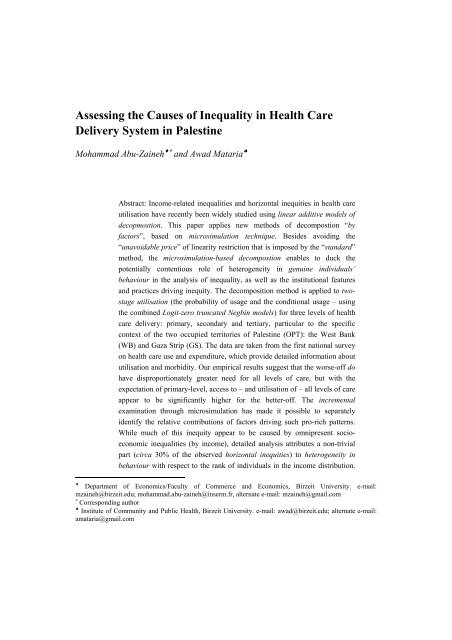The Palestinian Economy. Theoretical and Practical Challenges
The Palestinian Economy. Theoretical and Practical Challenges
The Palestinian Economy. Theoretical and Practical Challenges
You also want an ePaper? Increase the reach of your titles
YUMPU automatically turns print PDFs into web optimized ePapers that Google loves.
Assessing the Causes of Inequality in Health Care<br />
Delivery System in Palestine<br />
Mohammad Abu-Zaineh <strong>and</strong> Awad Mataria <br />
Abstract: Income-related inequalities <strong>and</strong> horizontal inequities in health care<br />
utilisation have recently been widely studied using linear additive models of<br />
decopmostion. This paper applies new methods of decompostion “by<br />
factors”, based on microsimulation technique. Besides avoiding the<br />
“unavoidable price” of linearity restriction that is imposed by the “st<strong>and</strong>ard”<br />
method, the microsimulation-based decompostion enables to duck the<br />
potentially contentious role of heterogeneity in genuine individuals’<br />
behaviour in the analysis of inequality, as well as the institutional features<br />
<strong>and</strong> practices driving inequity. <strong>The</strong> decomposition method is applied to twostage<br />
utilisation (the probability of usage <strong>and</strong> the conditional usage – using<br />
the combined Logit-zero truncated Negbin models) for three levels of health<br />
care delivery: primary, secondary <strong>and</strong> tertiary, particular to the specific<br />
context of the two occupied territories of Palestine (OPT): the West Bank<br />
(WB) <strong>and</strong> Gaza Strip (GS). <strong>The</strong> data are taken from the first national survey<br />
on health care use <strong>and</strong> expenditure, which provide detailed information about<br />
utilisation <strong>and</strong> morbidity. Our empirical results suggest that the worse-off do<br />
have disproportionately greater need for all levels of care, but with the<br />
expectation of primary-level, access to – <strong>and</strong> utilisation of – all levels of care<br />
appear to be significantly higher for the better-off. <strong>The</strong> incremental<br />
examination through microsimulation has made it possible to separately<br />
identify the relative contributions of factors driving such pro-rich patterns.<br />
While much of this inequity appear to be caused by omnipresent socioeconomic<br />
inequalities (by income), detailed analysis attributes a non-trivial<br />
part (circa 30% of the observed horizontal inequities) to heterogeneity in<br />
behaviour with respect to the rank of individuals in the income distribution.<br />
<br />
Department of Economics/Faculty of Commerce <strong>and</strong> Economics, Birzeit University. e-mail:<br />
mzaineh@birzeit.edu; mohammad.abu-zaineh@inserm.fr, alternate e-mail: mzaineh@gmail.com<br />
Corresponding author<br />
Institute of Community <strong>and</strong> Public Health, Birzeit University. e-mail: awad@birzeit.edu; alternate e-mail:<br />
amataria@gmail.com
















